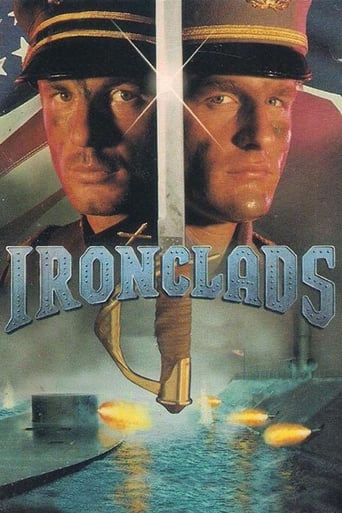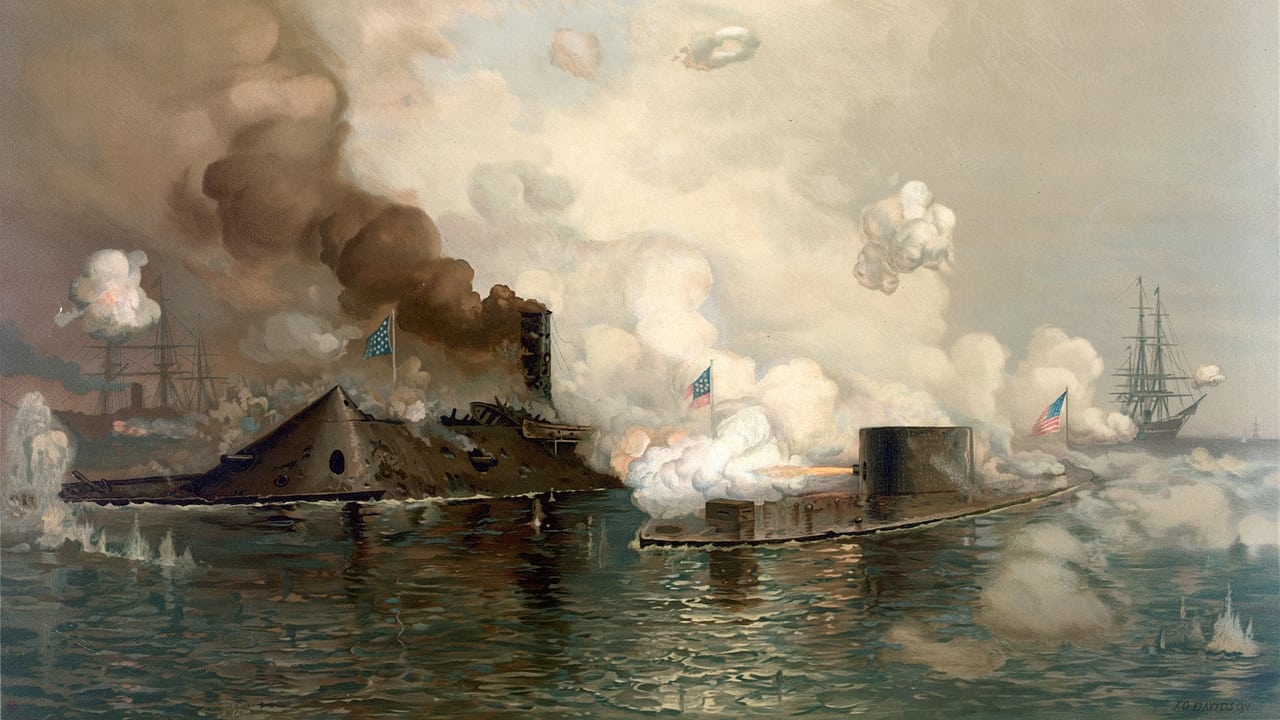floridawar
I remember reading with great relish of this impending project in the pages of Civil War Times Illustrated back in 1990. Fresh off the heels of Glory, I was hooked and couldn't wait for the next BIG Civil War flick. Well, I finally saw it on cable a year later, and was generally disappointed. Regardless, I recently purchased a copy on VHS and have watched it a couple of times to kill time. My conclusions are as follows:The love story is boring. I can only assume that the only reason it is included here is because the script was based to some degree on the two previous Monitor/Merrimac films (Confederate Ironclad (1910), and Hearts in Bondage (1936); though I have never seen either, both revolve around a female spy/love story/battle of the ironclads triad).The espionage factor is interesting, and even more so Madsen's character's conversion from a Union spy to to something of a double agent (of course to save her boyfriend, see love story above...)Overall I must conclude that the above was all just filler to keep production costs down. The love story is even absent on the cover art of the video box (features two models rather than production stars). One of the actors says in the movie "iron doesn't float," and that is certainly true of the leaden script employed here. Alas, there are no elements relating to the extraordinary construction of the two main protagonists: the Monitor and Merrimac! These last two are the real stars of this production.When the above stars of the show do arrive, the tempo picks up as imagination is put into gear. I actually like the last half of the flick, and find the battle scenes well done for a television production. I almost wish they had just made a straight up documentary out of the models and action scenes. Unfortunately there are the obligatory cutaways to the perils of the love interest/spy/girlfriend...But hey, its a TV movie, and kills some time. I can recommend it only for the special effects, and for naval buffs.
St. Louis Assassin .
This a One of Kind Civil War movie Firt let me say that Virginia Madsen never looked as Beautiful as she does in this movie.But this is the only Civil War movie that I've seen that deals with the naval battles. I think that this movie is very well crafted, and the cinematographic is wonderful. My only complaint about this movie is the dialog. At times the dialog is down right silly. However the actors do a great job with their roles The battle scenes are very well done.If you are a history buff.. you will absolutely love this movie. It has no boring parts. Its just good. I hope someday it will be released on DVD, because my VHS copy is starting to show signs of wear and tear
theowinthrop
In 1900, if one was studying the Civil War, an American student would have had some very brief discussion of the slavery issue. It would have mentioned the North was opposed to it, and the South favored it. That brief discussion would have been it - nothing further about slavery. The heroes and heroines of the war would have been more detailed. Grant, Lee, Sherman, Jackson, Lincoln, Davis would have been mentioned. So would have Farragut, Buchanan, David Porter, Semmes, Sheridan, Early, Joseph and Albert Johnston, John Bell Hood, Longstreet,McClellan, Hooker, Meade, Bragg, Rosecrans, Thomas, Schofield, Custer, A.P. and D.H. Hill...an endless list of heroes. It's doubtful if Frederick Douglas or Sojourner Truth or Harriet Tubman would have been mentioned (except in Black schools). John Brown would have to be mentioned because of the raid on Harper's Ferry, but his reputation would have been different in the school depending on who discussed him. The majority of these names were dropped out of discussions of that war by the time that the "baby boomers" generation showed up (1944 - 1970). Even the success of Ken Burn's CIVIL WAR series has not pushed these names back into the classrooms. The naval portion of the war was always limited. There were many ship to ship fights, but the only commander on the Northern side who became truly famous was David Glasgow Farragut, who won a series of naval victories, most noteworthy at New Orleans in 1862 and at Mobile Bay in 1864 (capped by his quote: "Damn the Torpedoes and Full Speed Ahead!). He certainly deserves our respect for his work. The best remembered Confederate naval hero was (of course) Captain (later C.S.S. Admiral) Raphael Semmes, who (while commanding the C.S.S. Alabama) became the greatest commerce raider in our history. But the naval battles we recall today were not under these men. They involved two experimental ironclad warships - C.S.S. Virginia and U.S.S. Monitor - off Hampton Roads, Virginia, and the sinking of the U.S.S. Housatonic off Charleston by the Confererate submarine C.S.S. Hunley. We do not recall the two commanders at Hampton Roads (Confederate Commodore Franklin Buchanan and Union Lt. John Worden). Neither really demonstrated a flair for tactics, as they slugged it out on March 9, 1862. They really did not quite know what to do with their two machines. The "cheesbox" turret of the Monitor was hit once or twice, but it's swiveling action prevented real damage. The thick armor plating of the Virginia (formerly the U.S.S. Merrimac) was dented occasionally, but it was not breached. The battle was a draw - but it showed that battleships would have to be metal from now on. The reason was the comparative one: The Virginia/Merrimac had attacked the Union fleet on March 8, 1862 at Hampton Roads, and sunk the U.S.S. Cumberland and the U.S.S. Congress, and caused the U.S.S. Minnesota to run aground. Up to Pearl Harbor that was the worst naval disaster inflicted by an enemy on the U.S. navy. But those ships were wooden.The Second Battle of Hampton Roads became a textbook battle in naval history from the point of view of innovation - not tactics. It's full effect is a little exaggerated: Both Britain and France had started building iron hulled warships like H.M.S. Warrior before 1860. But none had been tested in battle. Now everyone knew what to expect. The subsequent Hunley experiment showed another step forward in naval warfare: one underwater one.Oddly the Monitor/Merrimac fight has rarely been discussed in movies. A "B-feature" was made in the 1930s that showed the battle at the end. And there is this passable film made in 1991 by Ted Turner's production company for T.N.T. It is best showing the difficulties of the North dealing with the builder of U.S.S. Monitor, the gifted Swedish inventor John Ericcson, who was an egomaniac. Ericcson is played by Fritz Weaver, who gives a nice performance. But it is not the central portion of the film. The battle concludes it. I'm giving a "7" for Weaver's performance, and for a brief, sad moment (well handled) when E.G.Marshall realizes that his son is dead. Marshall's son commanded the Cumberland, and he realizes that if the ship sank the son has to be gone (he is).In all the hoopla of the finding of the "Hunley" and it's restoration in Charleston, few noticed that the Monitor's wreck (off Cape Hatteras) was found in the 1970s, and (in the face of deterioration) the turret and other portions of the wreck were raised and are being restored at Hampton Roads. The Merrimac had to be blown up in May 1862 to prevent it being seized by the North. Some fragments of that ironclad still exist.
rixrex
This mediocre claptrap about the great battle of the ironclads was nominated by the politically correct Emmy Awards committee because it was a 1990 politically correct way of presenting the greatest naval battle of the civil war, completely sanitized and with abundant civility. The whole dramatic story wrapped around the events of the great battle was so much hokum and corn, it was hard to wade through to get to the well-done battle sequences. One example of this, just one of many, is the degrading of a slave, only verbally mind you, in front of a Yankee spy masquerading as a Southern sympathizer. The slave was called whatever a TV censor would allow to pass muster, so the kids could watch, and then we see the Yankee spy clench his teeth and hold in his indignation. Later he confesses that he never witnessed such abuse. Yeah, right, like nobody in the North ever said anything but a kind word to blacks at that time. One can only imagine how such a scene would have been handled in a film like, say, Cold Mountain, where the slave would have gotten a terrible beating, and the evils of slavery and bigotry would have been roundly exposed, rather than whitewashed, no pun intended. It didn't win any Emmy awards because it didn't even deserve the nominations. But the scenes around the building of the ships and the battle were very good overall, except for the portrayal of Lincoln as a simpleton of sorts. I lay the fault of that to the actor, for the same lines said by someone of stature and strength would show strength of conviction.


 AD
AD


